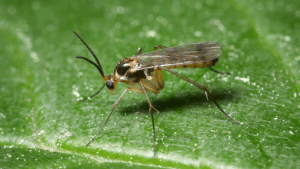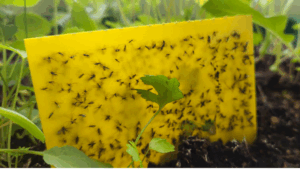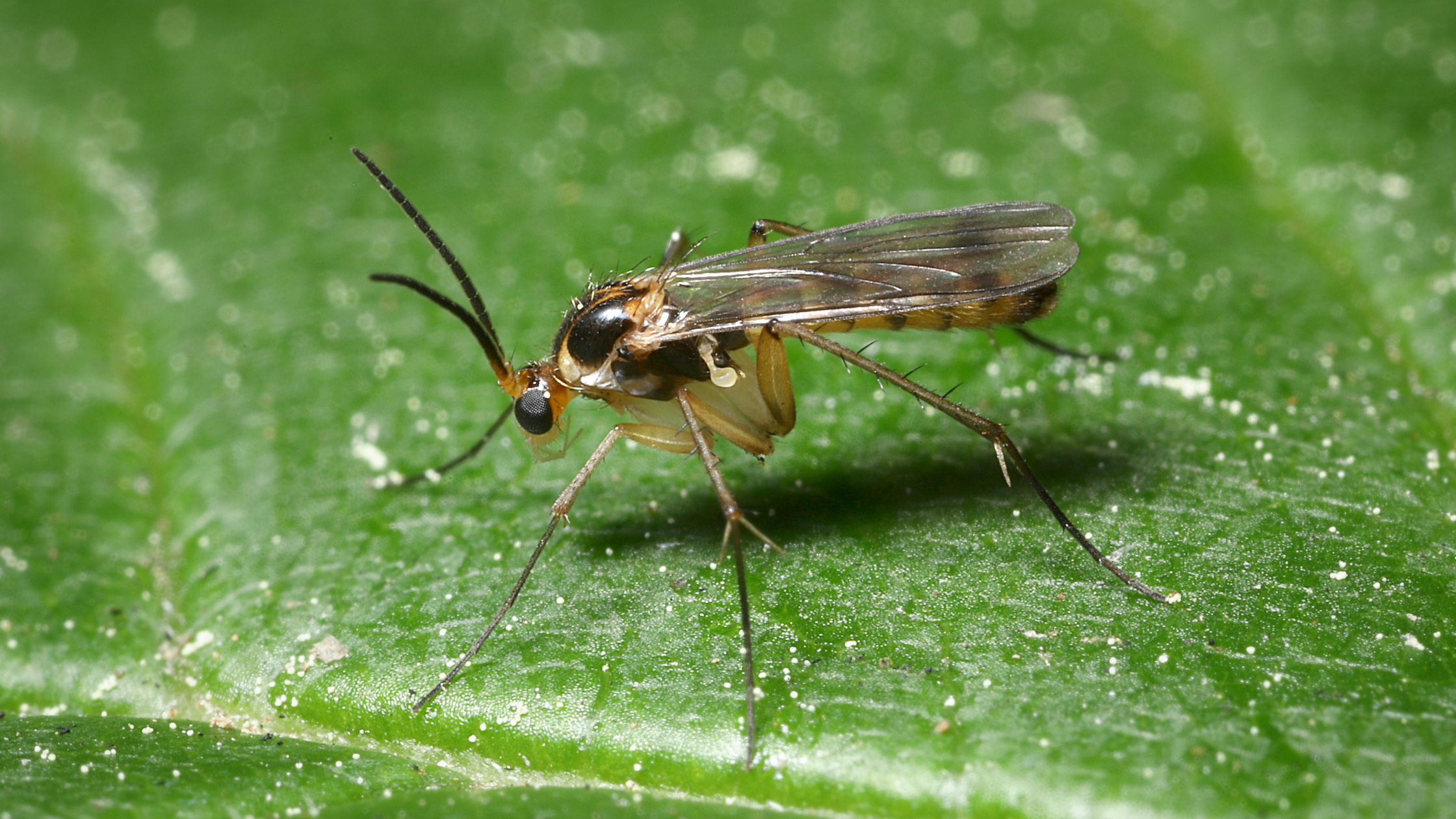.
Nearly everybody who has indoor plants will sooner or later make the dubious acquaintance of fungus gnats. Not only but especially in winter, those tiny black insects whirl up from the soil when we water our plants and fly around seemingly aimlessly. Unfortunately, fungus gnats are not only an annoying or aesthetic problem but a real threat to our seedlings because they like to nibble on plant roots! If we only had two or three gnats taking a small bite out of the roots, that wouldn’t be a problem. However, as it happens, fungus gnats never work alone but rather in clouds of gazillions. You can imagine the havoc these numbers can wreak among our baby vegetables. In order to find out how to get rid of fungus gnats, we first must look at what they are exactly.
What are fungus gnats?

Fungus gnats can be found all over the world. In Europe, there are around 600 different types. They are related to midges but cannot sting. In nature, especially in woods or moors, but also in gardens, their larvae play an important role as they decompose organic material.
Fungus gnats are often introduced with potting soil that already contains eggs or larvae, but they can also get into the house through open windows.
You have an infestation when swarms of 2 – 4 mm small black insects rise from the pots every time you move or water them. Contrary to fruit flies, fungus gnats have long legs and feelers as well as large wings. They preferably lay their eggs in the moist soil of indoor plants, and one female can lay up to 200 eggs, out of which wormlike, about 5 – 7 mm long white larvae hatch. They live in large groups in the moist soil. After about 13 days, the larvae pupate, and five to six days later, the fungus gnats hatch.
What damages do fungus gnats cause?
While the black fungus gnats are only pesky, their larvae, which live in the soil, eat not only dead plant parts but also the plants’ roots. Large plants can usually cope with that, but seedlings and cuttings can die. The damaged roots can’t take up enough water and nutrients, and bacterial and fungal diseases can penetrate into the plant through the open roots.
How to get rid of fungus gnats
Now, the good news is that there are ways to get rid of those little black beasts – and without throwing a chemical bomb into your living room. Read on!
Prevention
Prevention, they say, is better than cure. So the best way to get rid of fungus gnats is to not let them in in the first place.
Soil preparation
Since we mostly bring fungus gnats in ourselves with the soil we use for potting or seed starting, it’s certainly a great idea to give that a closer look. Only buy high-quality potting soil in undamaged sacks. If you use your own potting preparation, for example with compost, sterilise it before use. For that purpose, heat the soil in the oven at 150 °C (300 °F) for 30 minutes and let it cool down.
Watering correctly

As fungus gnats need moist soil to survive, we should only water our plants when the surface is really dry. However, this can be a bit tricky with seedlings as they must not dry out. It’s better to water several times a week with little water instead of once with a lot. Reliable water monitoring is essential when it comes to healthy seedlings and getting rid of fungus gnats.
Traps

There are those yellow sticky traps that you can put into the planting pots. They attract (amongst others) fungus gnats, which will stick to the gluey cards. However, those traps only catch the male gnats, and although males and females are necessary for producing fertilised eggs, sticky traps are not enough to get rid of all the gnats in your home. The traps are an indicator of an infestation and also a good addition to the next steps:
Natural antagonists
Nematodes
There is a kind of secret weapon, like a SWAT team, in the battle against fungus gnats: nematodes (Steinernema feltiae or SF-nematodes). They are minuscule, wormlike animals that live in the soil and kill fungus gnats’ larvae. Sounds disgusting, but it works wonderfully and is a great non-chemical way of getting rid of our plants’ unwanted roommates.
You can buy nematodes online. They come in small packages and look like a powder that you have to dilute with water. I always use a large mason jar for that, and then add the dilution to the watering can, where I fill it up with more water.
Before you spread the nematodes, however, the potting soil must already be moist. Nematodes (like fungus gnats) die in dry soil, so water your plants in advance, then bring out the nematodes and keep the soil moist during the next weeks. It usually takes about 2 – 4 weeks to notice a considerable decline in fungus gnats.
Predatory mites
Like nematodes, predatory mites also find fungus gnats irresistible. You can use the types Hypoaspis miles, Hypoaspis aculeifer Macrocheles robustulus. They usually come as a granulate that you spread on top of the soil.
Bacteria
Special bacteria, like Bacillus thuringiensis subsp. Israelensis are also a good weapon against fungus gnats. Like nematodes, they are diluted in water and poured on the potting soil with a watering can.
Neem oil
Neem oil affects insects’ hormonal system and prevents them from forming chitin, so that they will not reach the stage of mature gnats and, as a consequence, are not able to reproduce. If you are sure that there are no beneficial insects in the vicinity that you want to spare, neem oil is a good way to get rid of fungus gnats. I wouldn’t use it outside, though, for fear of affecting bees and other pollinators.
Soil cover
A well-known home remedy to prevent the gnats from laying their eggs in the soil is to cover it with quartz sand, where the flies will not get through it. However, the layer should be about 1 cm (0.5 inches) thick. Sprinkle a bit of baking soda on top of the sand to set a double barrier.
Tempting as it might be, however, do not cover your potting soil with organic material as that provides nourishment for the gants and larvae.
However tedious, fungus gnats are not one of the seven plagues, and as easily as we can bring them in unconsciously, we can get rid of them. It’s best, of course, to take precautions, but as you have seen above, there are also several non-chemical ways to protect our green friends from those root nibblers.
More garden talk? Read on here:
Seed-starting cucumbers: how to get healthy seedlings
23 Common Vegetable Gardening Mistakes (And How to Fix Them!)
Succession Planting Guide: Maximize Your Vegetable Garden Harvest Year-Round


0 Comments